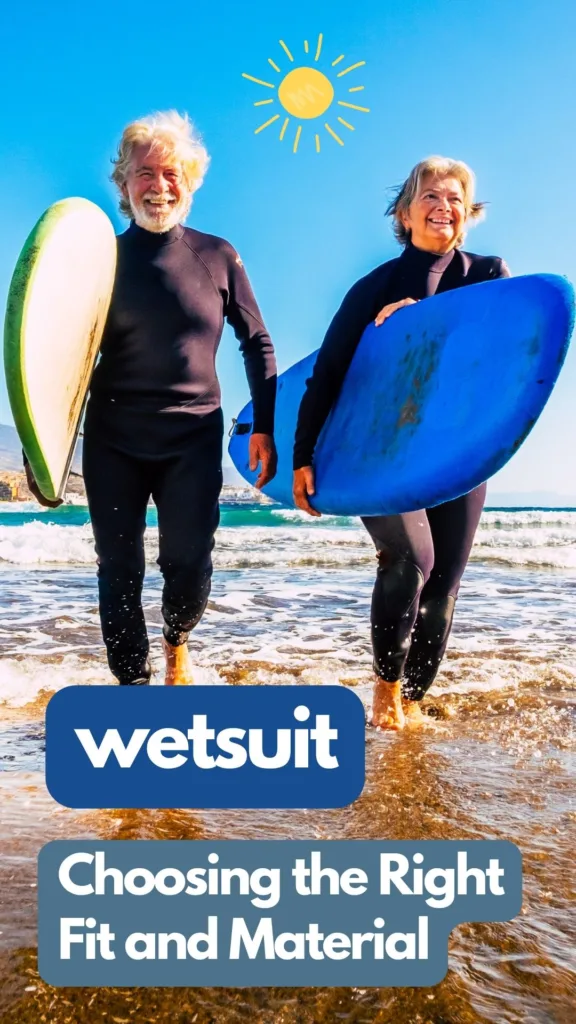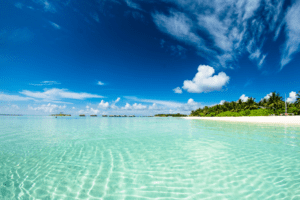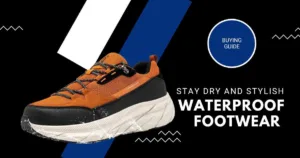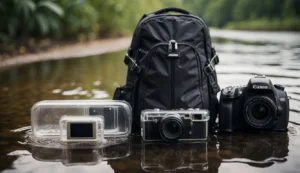Wetsuit Essentials: Choosing the Right Fit and Material
When exploring the world of water sports, a wetsuit is an essential gear that allows you to maintain body warmth in cooler waters. Made from neoprene, these suits come in various thicknesses, suitable for different water temperatures and activities. Whether you’re diving, surfing, or participating in other aquatic sports, a wetsuit helps to increase your comfort and performance by providing thermal insulation and some buoyancy.
The design and fit of a wetsuit are crucial for its function. It should be snug enough to form a thin layer of water between you and the suit, which your body then heats, providing an insulating barrier. However, a suit that’s too tight can restrict movement and be uncomfortable. Options range from full suits, which cover your entire body, to spring suits, which have shorter arms and legs, depending on your needs and the conditions you will be facing.
When selecting a wetsuit, you’ll need to consider the thickness, which is usually measured in millimeters, and the cut that’s best for your activities. The thicker the neoprene, the warmer the suit will be. Advanced features, such as sealed seams, can also improve water tightness and warmth. With a proper wetsuit, you can extend your time in the water, enhance your performance, and enjoy water activities even in cooler temperatures.
History of Wetsuits


Your understanding of wetsuits starts with Hugh Bradner, a physicist who, in the early 1950s, recognized the need for improved insulation for divers. While working with the University of California, Berkeley, Bradner conceived the idea of trapping water between the suit and the skin to maintain body heat, which led to the creation of the first neoprene wetsuit.
The evolution of wetsuits is characterized by gradual improvements in materials and design. Initially, neoprene was sandwiched between layers of nylon or spandex to improve durability. Over time, manufacturing techniques became more sophisticated, allowing for better fit and enhanced seam sealing.
The success of Bradner’s wetsuit concept eventually sparked competition and innovation within the industry. Jack O’Neill, among others, played a significant role in popularizing wetsuits for various water sports. Their insulative properties significantly extended the time individuals could spend in the water, revolutionizing water activities like surfing, diving, and windsurfing.
Your appreciation for this apparel grows with the knowledge that wetsuits not only provide thermal protection but also safety from abrasion, UV exposure, and marine stings.
- Early 1950s: Invention by Hugh Bradner
- Subsequent Years: Material and design enhancements
- Notable Figure: Jack O’Neill promotes wetsuit use
Today, wetsuits are a staple for water enthusiasts, reflecting a history of ingenuity and progressive refinement.
Materials and Fabrication


When choosing a wetsuit, it’s essential to understand the role of materials used and their fabrication process as they dictate the suit’s performance, comfort, and durability.
Neoprene Types
Neoprene is the core material in wetsuit construction, offering thermal insulation and flexibility. The quality of neoprene varies with the specific composition and manufacturing process. Some wetsuits utilize Yamamoto neoprene, which is known for its higher flexibility and better insulation. High-grade neoprene, distinguished by higher numbers like #39 and #40, enhances the wetsuit’s performance and fitting.
Fabric Linings
The fabric linings bonded to neoprene sheets are crucial for comfort and durability. Internal linings often vary, with some designed for additional warmth, while others aim at increasing flexibility. Common lining materials include nylon and polyester, complementing the neoprene’s properties and affecting the wetsuit’s overall feel.
Seam Construction
Seams significantly impact a wetsuit’s strength and water tightness. Basic wetsuits have flatlock seams, suited for warmer waters. For colder conditions, sealed seams that are glued and blind-stitched provide enhanced, water-resistant seals. Some high-end wetsuits feature taped or welded seams for maximum integrity and minimal water entry.
Wetsuit Types


When you’re selecting a wetsuit, the main types you’ll encounter are full wetsuits, spring suits, and shorties. Each serves a specific purpose, depending on water temperature and desired mobility.
Full Wetsuits
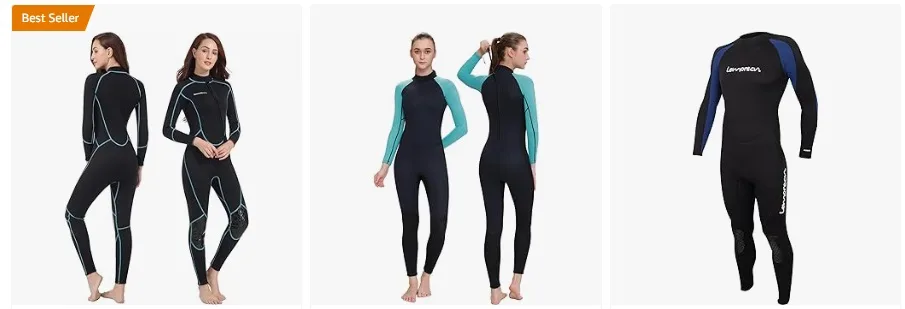

Full wetsuits cover your entire body—torso, arms, and legs—and are designed for use in colder waters. They come in varying thicknesses, typically ranging from 3 mm to 6 mm, directly correlating with the water temperature they can handle. A full wetsuit is your go-to for most surfing, diving, and open-water swimming needs in cooler environments.
- Thickness:
- 3 mm (warm water)
- 4 mm (moderately cold water)
- 5/6 mm (cold water)
Spring Suits
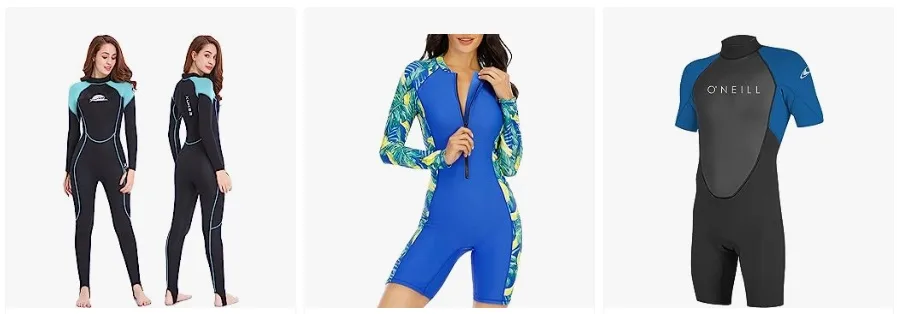

Spring suits provide coverage to the torso and upper parts of your legs and arms. They are ideal for use during warmer conditions or during transitional seasons like spring and fall. Often constructed with a neoprene thickness of around 2 mm, spring suits offer a balance between warmth and flexibility, allowing for more freedom of movement.
- Coverage:
- Torso
- Thighs
- Upper arms
Shorties
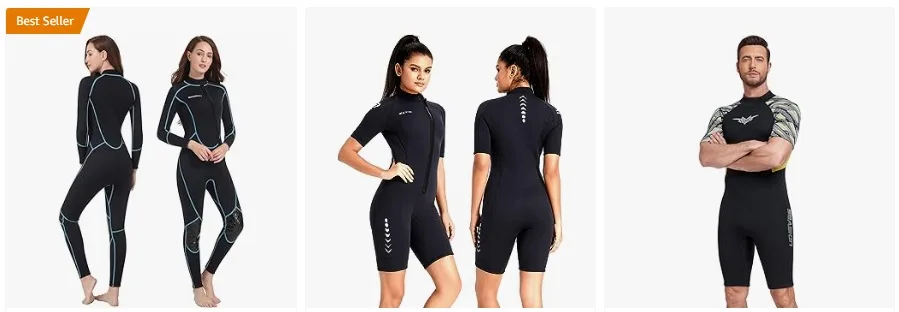

Shorties, or shorty wetsuits, are similar to spring suits but with even shorter arms and legs. The typical design covers your torso and shoulders and includes shorts that extend to mid-thigh. Best suited for warm water environments, shorties are a popular choice when minimal insulation and maximum range of motion are priorities.
- Design:
- Short sleeves
- Short legs (mid-thigh)
Remember, the right wetsuit type not only contributes to your comfort and warmth but also enhances your overall performance in the water.
| Water Temperature | Wetsuit Thickness | |
|---|---|---|
| 65-69°F | 18-21°C | 2mm (short or spring wetsuit) |
| 62-64°F | 17-18°C | 2mm (full or spring wetsuit) |
| 58-61°F | 14-17°C | 3/2mm (full wetsuit) |
| 54-57°F | 12-14°C | 4/3mm (full wetsuit with 3mm boots) |
| 50-53°F | 10-12°C | 4/3mm (full wetsuit, 2mm hood, 3mm boots and gloves) |
| 47-49°F | 8-9°C | 5/4/3 (full wetsuit + hood, 5mm boots and gloves) |
| > 46°F | > 8°C | 6/5/4 (full wetsuit + hood, 7mm boots and gloves) |
Design Features


Wetsuit design features enhance performance, comfort and flexibility in water. Each element plays a critical role in function and fit.
Zippers
Your wetsuit might have a back zipper which allows for easy entry and exit. This traditional style of zipper is known for its convenience. Alternatively, a chest zip design offers a better water seal and can enhance upper body flexibility while swimming.
Seals and Flaps
To prevent water from entering, wrist and ankle seals are crucial. These tight-fitting closures ensure minimal water exchange. Additionally, zipper flaps offer extra protection against water entry and can also prevent the zipper from causing discomfort against your spine.
Thermal Properties
The heart of a wetsuit’s warmth lies in its neoprene construction. Neoprene comes in varying thicknesses, typically measured in millimeters. The thicker the neoprene, the warmer the suit. For colder conditions, you might consider a suit with a thermal lining for additional heat retention.
Fit and Sizing


Finding the right wetsuit is crucial for both comfort and performance in water activities. It’s important to know your measurements and how a wetsuit should feel once on.
Measuring Guides
Begin by accurately measuring your height, weight, chest, and waist. For males and females, chest measurement is the most critical, as it influences the overall fit the most. Consult wetsuit size charts to cross-reference your measurements with the sizes available for various brands.
- Height: Measured from the top of your head to the bottom of your feet.
- Weight: Best taken in the morning for more accuracy.
- Chest: Measure around the widest part of your chest.
- Waist: Measure around your natural waistline.
Remember, different brands may have slight variations in sizing, so always check the brand’s specific size chart.
Fit Considerations
A proper-fitting wetsuit should feel like a second skin, tight but not constrictive. While putting on the wetsuit, ensure that there are no excess gaps and that it allows for full range of motion. Pay attention to the fit around your neck, back, and knees, where water can seep in if the suit is too loose.
- Tightness: The wetsuit should be snug, as a looser wetsuit can cause chafing.
- Comfort: While needing to be tight, ensure breathing is not restricted.
- Neoprene Stretch: Neoprene will stretch slightly over time, so a snug fit initially is acceptable.
In between sizes? Some brands offer “Long” or “Short” versions to better accommodate different body shapes. If you’re in between sizes, exploring different brands or specific models might yield a better fit. Opting for a custom-tailored wetsuit is another solution if you’re unable to find an optimal off-the-rack fit.
The chart below is a general guide to help you start with finding the right wetsuit size. Remember, the fit should be snug but not restrictively tight, as a properly fitting wetsuit will keep you warm and allow for maximum mobility in the water. Always try on a wetsuit if possible before purchasing, and consider any specific needs you might have, such as additional room in certain areas or preference for a tighter fit to ensure minimal water entry.
Women
| Wetsuit Size | Height (feet/cm) | Weight (lb/kg) | Chest (in/cm) | Waist (in/cm) |
|---|---|---|---|---|
| XS | 5’4″-5’6″ / 162-167 | 110-120 / 50-54 | 31-33 / 79-84 | 24-26 / 61-66 |
| S | 5’5″-5’7″ / 165-170 | 120-130 / 54-59 | 33-35 / 84-89 | 25-27 / 63-68 |
| M | 5’6″-5’8″ / 167-172 | 130-140 / 59-63 | 34-36 / 86-91 | 26-28 / 66-71 |
| MT | 5’7″-5’9″ / 170-175 | 135-145 / 61-65 | 34-36 / 86-91 | 26-28 / 66-71 |
| L | 5’7″-5’9″ / 170-175 | 140-150 / 63-68 | 36-38 / 91-97 | 28-30 / 71-76 |
| LT | 5’8″-5’10” / 172-177 | 145-155 / 65-70 | 36-38 / 91-97 | 28-30 / 71-76 |
| XL | 5’8″-5’10” / 172-177 | 150-160 / 68-72 | 38-40 / 97-102 | 30-32 / 76-81 |
| XLT | 5’9″-5’11” / 175-180 | 155-165 / 70-75 | 38-40 / 97-102 | 30-32 / 76-81 |
| XXL | 5’9″-5’11” / 175-180 | 160-170 / 72-77 | 40-42 / 102-107 | 32-34 / 81-86 |
Men
| Wetsuit Size | Height (feet/cm) | Weight (lb/kg) | Chest (in/cm) | Waist (in/cm) |
|---|---|---|---|---|
| XS | 5’5″-5’7″ / 165-170 | 125-135 / 56-61 | 34-36 / 86-91 | 28-30 / 71-76 |
| S | 5’7″-5’9″ / 170-175 | 135-155 / 61-70 | 36-38 / 91-97 | 29-31 / 74-79 |
| M | 5’9″-5’11” / 175-180 | 155-175 / 70-79 | 38-40 / 97-102 | 31-33 / 79-84 |
| MT | 5’11”-6’1″ / 180-185 | 160-180 / 72-81 | 38-40 / 97-102 | 31-33 / 79-84 |
| L | 5’11”-6’1″ / 180-185 | 175-195 / 79-88 | 40-42 / 102-107 | 33-35 / 84-89 |
| LT | 6’1″-6’3″ / 185-190 | 180-200 / 81-90 | 40-42 / 102-107 | 33-35 / 84-89 |
| XL | 6’1″-6’3″ / 185-190 | 195-215 / 88-97 | 42-44 / 107-112 | 35-37 / 89-94 |
| XLT | 6’3″-6’5″ / 190-195 | 200-220 / 90-99 | 42-44 / 107-112 | 35-37 / 89-94 |
| XXL | 6’2″-6’4″ / 187-193 | 215-235 / 97-106 | 44-46 / 112-117 | 37-39 / 94-99 |
Performance and Mobility


In triathlon wetsuits, your performance and mobility are influenced by the suit’s stretch and flexibility, as well as the buoyancy it provides.
Stretch and Flexibility
Your wetsuit should allow for maximum stretch and flexibility to enable a full range of movement, which is crucial during the swim portion of a triathlon. High-quality wetsuits often leverage advanced materials that offer significant stretch without sacrificing durability. These materials, such as Yamamoto neoprene, enhance your ability to move freely and maintain an efficient stroke.
Buoyancy Effects
Buoyancy plays a pivotal role in maintaining a good swimming posture by providing hydrostatic lift. This lift helps bring your body into a more streamlined position, thus reducing drag. Wetsuits with targeted buoyancy zones can assist in elevating your lower body, equating to less fatigue and improved swim times. It’s important to choose a wetsuit with the right level of buoyancy to complement your body composition and swimming style.
Buoyancy in wetsuits refers to the ability of the suit to help the wearer float in water. This characteristic is particularly important for activities such as scuba diving, snorkeling, and swimming, where controlling your position in the water is crucial. The buoyancy level of a wetsuit is influenced by several factors, including the thickness of the neoprene, the type of neoprene, and the suit’s overall design. Here’s a breakdown of how these factors affect a wetsuit’s buoyancy:
Thickness
- Thicker Neoprene: Provides more buoyancy because thicker neoprene contains more nitrogen gas bubbles, which are responsible for the flotation effect. Wetsuits can range from about 2mm (thin, less buoyant, suitable for warm water) to 7mm (thick, more buoyant, designed for cold water). The thicker the wetsuit, the more buoyant it will be, but it will also be less flexible.
Type of Neoprene
- Closed-cell Neoprene: Most traditional wetsuits are made from this type, which has gas bubbles encapsulated within the material, providing inherent buoyancy.
- Open-cell Neoprene: Has a different internal structure and is generally used in spearfishing suits. It can offer buoyancy but is more focused on insulation and flexibility.
Suit Design
- Full Suits vs. Shorties: Full suits cover more of the body and can offer more buoyancy due to the increased amount of neoprene. Shorties (short-sleeved and ending above the knee) contain less neoprene, making them less buoyant but more suitable for warmer conditions.
- Additional Buoyancy Aids: Some wetsuits incorporate additional buoyancy aids, such as integrated air pockets or neoprene that has been specially treated to increase its buoyancy. These suits are particularly useful for beginners in water sports who may require extra help with flotation.
Considerations
- Water Temperature: Thicker wetsuits, while more buoyant, are also warmer. The choice of wetsuit thickness and, consequently, its buoyancy level, should consider the water temperature you’ll be entering.
- Activity Type: Activities that require deeper submersion or more flexibility might benefit from a less buoyant wetsuit, allowing for easier movement underwater.
Adjusting Buoyancy
For activities like scuba diving, where precise buoyancy control is essential, divers often use weight systems in conjunction with their wetsuits to counteract the buoyancy and achieve neutral buoyancy underwater.
Care and Maintenance


Proper care will significantly extend the life of your wetsuit. Ensure that you clean, store, and repair your wetsuit correctly, which keeps it functional and comfortable.
Cleaning Procedures
- After Each Use: Rinse your wetsuit with cool, fresh water to remove salt, chlorine, and other debris. Turn the suit inside out to ensure both sides are thoroughly cleaned.
- Deep Cleaning: Occasionally, use a wetsuit-specific cleaner and soak for a short period, then rinse thoroughly. Avoid using harsh detergents as they can damage the neoprene.
Storage Tips
- Avoid Folding: Store your wetsuit flat or on a wide hanger to prevent creases and maintain the neoprene’s integrity.
- Proper Environment: Keep it in a cool, dry place away from direct sunlight to prevent the neoprene from degrading.
Repair Techniques
- Small Tears: Use neoprene cement to bond tears and holes. Apply a thin layer, press firmly and allow it to dry completely.
- Seam Damage: If seams split, they can be repaired with a neoprene adhesive or, for a stronger fix, sewn using nylon thread and then sealed with liquid seam sealant.
Environmental Impact
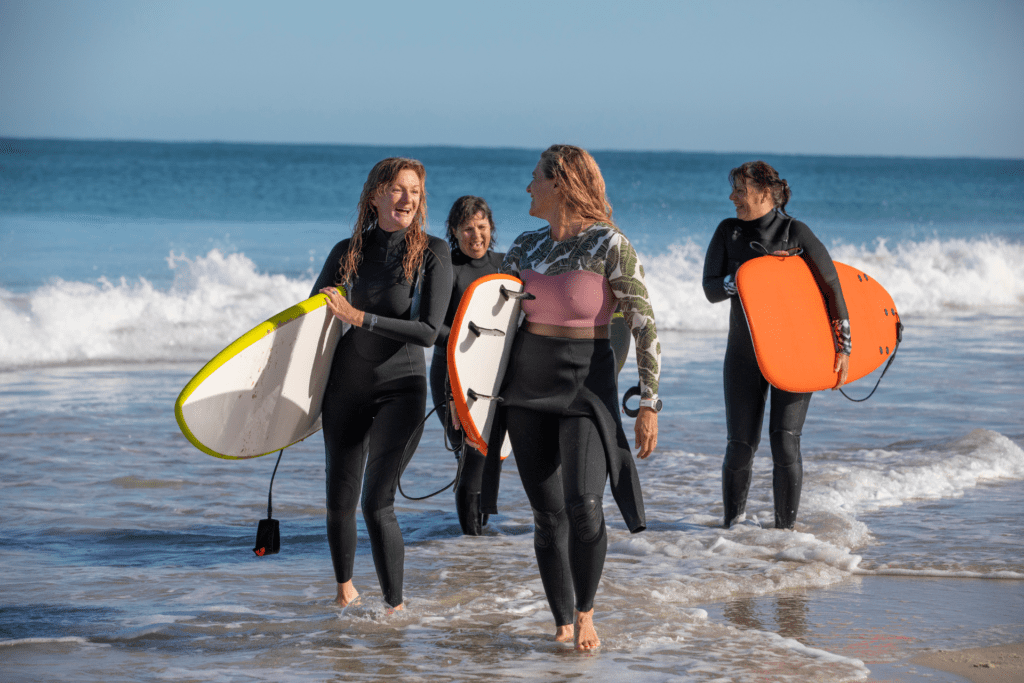

Wetsuits have traditionally been manufactured using materials and processes that pose a significant environmental challenge. As you consider purchasing a wetsuit, being aware of its ecological footprint is essential. Options that leverage sustainable practices offer a way to enjoy water sports while minimizing your impact on the planet.
Sustainable Materials
Your choice of wetsuit can contribute to environmental conservation. Emerging trends in the wetsuit industry have led to the use of sustainable materials. These include limestone-based neoprene, which reduces reliance on petrochemicals, and natural rubbers that present a renewable alternative. Manufacturers are also incorporating recycled plastics and non-toxic water-based adhesives to further reduce harm to ecosystems.
Recycling Programs
End-of-life recycling programs for wetsuits are an integral part of reducing waste. Brands such as Patagonia have implemented wetsuit recycling initiatives, encouraging you to return your old gear. These programs help repurpose materials into new products, preventing wetsuit waste from ending up in landfills and reducing the need for new raw materials.
Innovations in Wetsuit Technology


Wetsuit technology has seen substantial advancements, significantly improving your experience in the water. Key innovations include:
- Materials: Modern wetsuits utilize high-grade neoprene, which offers greater flexibility and warmth. Neoprene’s closed-cell structure contains tiny air bubbles, trapping warmth efficiently.
Strategic Thickness: The thickness of neoprene panels is varied to provide optimal buoyancy and flexibility. Areas around your shoulders and joints have thinner neoprene to allow for unrestricted movement.
Seam Construction: High-quality wetsuits now feature blind stitched and glued seams. These methods prevent water from seeping in, keeping you warmer for longer durations.
Thermal Linings: Some wetsuits incorporate thermal linings, which reflect body heat, providing extra thermal protection without adding bulk.
Zipper Innovations: Wetsuits now come with water-tight zippers. Advanced back and chest zippers reduce water entry and are easier to use, enhancing your comfort and extending your time in the water.
Eco-Friendly Options: There’s a growing trend toward sustainable wetsuit production, incorporating limestone-based neoprene or natural rubber. These materials aim to reduce environmental impact.
For a deeper understanding of these technologies, read about how wetsuit technology enhances both buoyancy and warmth without impacting technique. These innovations ensure that your performance in aquatic environments is not only sustained but also improved, reflecting years of research and development in the field of wetsuit design.
Choosing the Right Wetsuit
When selecting a wetsuit, your primary considerations should be the water temperature and the type of water activity you’ll be engaging in. Here’s a brief guide to aid you in making an informed choice:
Water Temperature: Wetsuits come in different thicknesses, which are usually measured in millimeters. The thicker the suit, the more insulation you get. Use a wetsuit thickness & temperature chart as a reference to find the appropriate thickness for your needs.
- Cold Water: Consider a full suit with a thickness of 5mm and above.
- Moderate Water: A thickness of 3mm to 4mm suits these conditions.
- Warm Water: A thickness of 2mm or less, or a shorty wetsuit, might be sufficient.
Fit and Style: Your wetsuit should fit snugly without being too restrictive, as a proper fit helps maintain your body heat. It’s important to find a balance between snugness and flexibility, especially around your chest and shoulders, to ensure free movement.
- Full Suit: Ideal for colder temperatures and provides full body coverage.
- Spring Suit: Short arms and legs, suitable for warmer temperatures.
Personal Preference: Comfort is key. You may prefer certain styles, such as a one-piece suit or a two-piece suit based on flexibility or ease of getting in and out of the suit.
Size: Accurate measurements are critical. Use a size guide to match your height, weight, and body measurements to the correct wetsuit size.
Remember, every aspect of your wetsuit impacts your warmth and performance in the water. Take the time to choose wisely.
Frequently Asked Questions
When selecting a wetsuit, it’s important to focus on fit, intended use, thermal insulation, cost, design differences based on activity, and proper maintenance to ensure longevity.
How do I choose the right size wetsuit for me?
The correct wetsuit fit should be snug but comfortable, allowing you a full range of motion. Ensure that there are no large gaps and that it does not restrict breathing; it should feel like a second skin. A poorly fitted wetsuit may not effectively keep you warm in the water.
What should I consider when selecting a wetsuit for triathlon competitions?
For triathlon competitions, prioritize a wetsuit designed for swimmers, which offers flexibility in the shoulders and buoyancy in the legs. Wetsuit thickness is regulated in competitions, so it’s crucial to follow guidelines to avoid disqualification. For triathlon-specific wetsuit features, check with the event’s rules.
How does a wetsuit provide warmth in cold water conditions?
Wetsuits trap a thin layer of water between the suit and your skin. Your body heats this layer, which serves as insulation against cold water. The thickness of the neoprene will depend on the water temperature, affecting heat retention.
Can I buy a quality wetsuit on a budget?
Yes, you can find a quality wetsuit on a budget by researching brands that offer durability and essential features without the premium price tag. Look for end-of-season sales and consider reputable wetsuit manufacturers that may offer discounts on older models.
What are the differences between wetsuits for surfing and other water activities?
Surfing wetsuits offer flexibility and comfort, typically featuring stretchy material in the upper body for paddling. In contrast, diving wetsuits are optimized for thermal protection and durability against underwater elements. Wetsuits for other water activities may vary in buoyancy and range of motion.
How do I properly care for and maintain my wetsuit?
Care for your wetsuit by rinsing it with fresh water after each use, avoiding exposure to direct sunlight when drying, and storing it on a wide hanger to prevent creases. Avoid folding the wetsuit, as this can cause damage over time. Regular maintenance ensures your wetsuit’s longevity.


